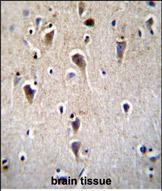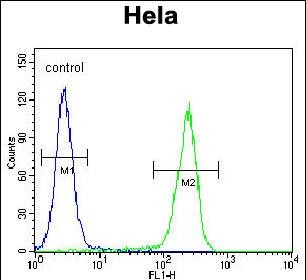CRFR2D Antibody
Affinity Purified Rabbit Polyclonal Antibody (Pab)
- SPECIFICATION
- CITATIONS
- PROTOCOLS
- BACKGROUND

Application
| FC, IHC-P, WB, E |
|---|---|
| Primary Accession | Q13324 |
| Other Accession | B3SXS6, NP_001189412.1 |
| Reactivity | Human |
| Host | Rabbit |
| Clonality | Polyclonal |
| Isotype | Rabbit IgG |
| Calculated MW | 47688 Da |
| Gene ID | 1395 |
|---|---|
| Other Names | Corticotropin-releasing factor receptor 2, CRF-R-2, CRF-R2, CRFR-2, Corticotropin-releasing hormone receptor 2, CRH-R-2, CRH-R2, CRHR2, CRF2R, CRH2R |
| Target/Specificity | This CRFR2D antibody is generated from rabbits immunized with a KLH conjugated synthetic peptide selected from the human CRFR2D. |
| Dilution | FC~~1:10~50 IHC-P~~1:50~100 WB~~1:1000 E~~Use at an assay dependent concentration. |
| Format | Purified polyclonal antibody supplied in PBS with 0.09% (W/V) sodium azide. This antibody is purified through a protein A column, followed by peptide affinity purification. |
| Storage | Maintain refrigerated at 2-8°C for up to 2 weeks. For long term storage store at -20°C in small aliquots to prevent freeze-thaw cycles. |
| Precautions | CRFR2D Antibody is for research use only and not for use in diagnostic or therapeutic procedures. |
| Name | CRHR2 |
|---|---|
| Synonyms | CRF2R, CRH2R |
| Function | G-protein coupled receptor for CRH (corticotropin-releasing factor), UCN (urocortin), UCN2 and UCN3. Has high affinity for UCN. Ligand binding causes a conformation change that triggers signaling via guanine nucleotide-binding proteins (G proteins) and down-stream effectors, such as adenylate cyclase. Promotes the activation of adenylate cyclase, leading to increased intracellular cAMP levels. |
| Cellular Location | Cell membrane; Multi-pass membrane protein |

Thousands of laboratories across the world have published research that depended on the performance of antibodies from Abcepta to advance their research. Check out links to articles that cite our products in major peer-reviewed journals, organized by research category.
info@abcepta.com, and receive a free "I Love Antibodies" mug.
Provided below are standard protocols that you may find useful for product applications.
Background
Liaw et al. (1996) [PubMed 8536644] stated that there are 2 G protein-coupled corticotropin-releasing hormone (CRH; MIM 122560) receptors, CRHR1 (MIM 122561) and CRHR2, which they termed the CRF2 receptor. CRH is a 41-amino acid peptide synthesized in the hypothalamus that is the principal neuroregulator of the hypothalamic-pituitary-adrenocortical axis and plays an important role in coordinating the endocrine, autonomic, and behavioral responses to stress and immune challenge.
References
Romero, R., et al. Am. J. Obstet. Gynecol. 203 (4), 361 (2010) :
Gutknecht, E., et al. Eur. J. Pharmacol. 642 (1-3), 1-9 (2010) :
Ruano, G., et al. Pharmacogenomics 11(7):959-971(2010)
Pinheiro, A.P., et al. Am. J. Med. Genet. B Neuropsychiatr. Genet. 153B (5), 1070-1080 (2010) :
Joubert, B.R., et al. Genome Med 2 (3), 17 (2010) :
If you have used an Abcepta product and would like to share how it has performed, please click on the "Submit Review" button and provide the requested information. Our staff will examine and post your review and contact you if needed.
If you have any additional inquiries please email technical services at tech@abcepta.com.













 Foundational characteristics of cancer include proliferation, angiogenesis, migration, evasion of apoptosis, and cellular immortality. Find key markers for these cellular processes and antibodies to detect them.
Foundational characteristics of cancer include proliferation, angiogenesis, migration, evasion of apoptosis, and cellular immortality. Find key markers for these cellular processes and antibodies to detect them. The SUMOplot™ Analysis Program predicts and scores sumoylation sites in your protein. SUMOylation is a post-translational modification involved in various cellular processes, such as nuclear-cytosolic transport, transcriptional regulation, apoptosis, protein stability, response to stress, and progression through the cell cycle.
The SUMOplot™ Analysis Program predicts and scores sumoylation sites in your protein. SUMOylation is a post-translational modification involved in various cellular processes, such as nuclear-cytosolic transport, transcriptional regulation, apoptosis, protein stability, response to stress, and progression through the cell cycle. The Autophagy Receptor Motif Plotter predicts and scores autophagy receptor binding sites in your protein. Identifying proteins connected to this pathway is critical to understanding the role of autophagy in physiological as well as pathological processes such as development, differentiation, neurodegenerative diseases, stress, infection, and cancer.
The Autophagy Receptor Motif Plotter predicts and scores autophagy receptor binding sites in your protein. Identifying proteins connected to this pathway is critical to understanding the role of autophagy in physiological as well as pathological processes such as development, differentiation, neurodegenerative diseases, stress, infection, and cancer.




